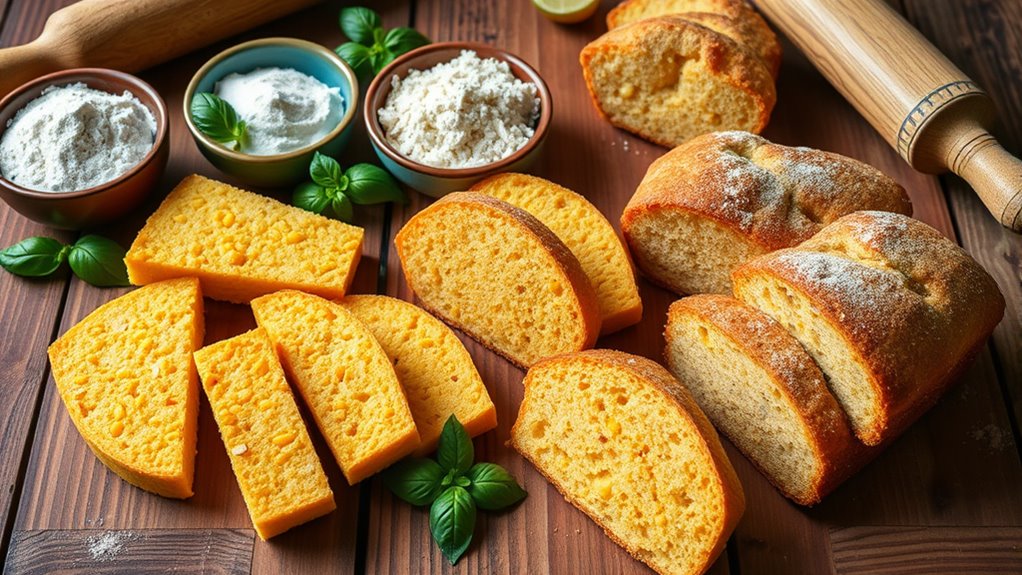To succeed in gluten-free Italian baking, choose flour blends like rice, chickpea, chestnut, almond, and cornstarch to mimic traditional textures and flavors. Use binders such as xanthan gum or psyllium to improve dough elasticity and cohesion. Handle the dough gently, adjust hydration levels, and incorporate authentic ingredients like herbs and olive oil for genuine taste. For more tips and effective flour swaps, explore how to optimize your baking techniques and ingredient choices.
Key Takeaways
- Combine regional gluten-free flours like rice, chestnut, and chickpea to mimic traditional Italian bread flavors and textures.
- Use natural binders such as xanthan gum or psyllium husk to improve dough elasticity and structure.
- Hydrate dough properly and handle it gently to achieve a desirable crumb and avoid crumbliness.
- Adjust hydration levels and fermentation techniques to enhance rise and flavor in gluten-free Italian baked goods.
- Store baked items in airtight containers and freeze to maintain freshness and authentic taste.
Choosing the Right Gluten-Free Flours for Italian Baking
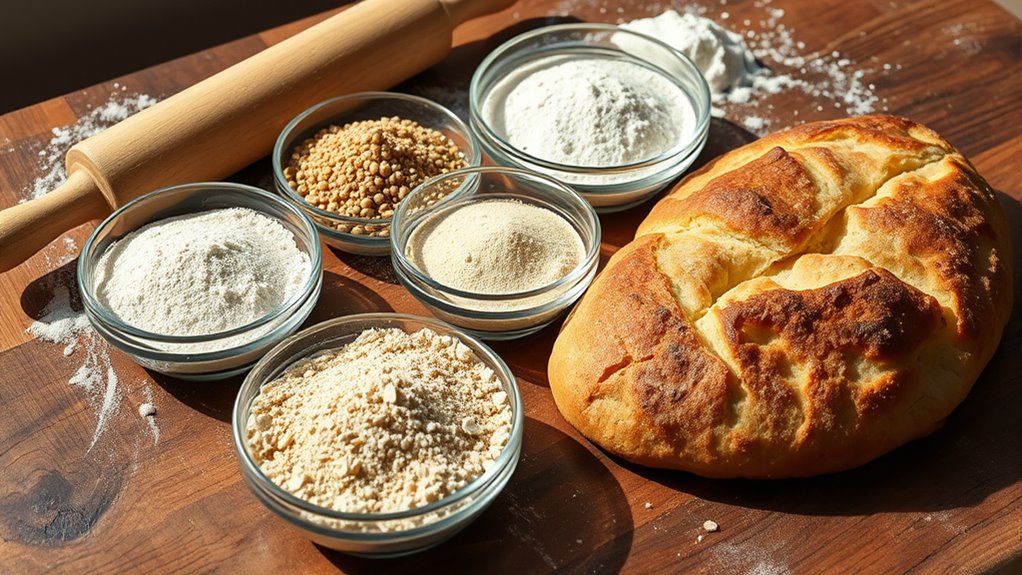
When selecting gluten-free flours for Italian baking, it’s important to understand the unique qualities of each type. For example, rice flour creates a light texture suitable for gluten-free bread, while chickpea flour adds a hearty flavor perfect for savory Italian dishes. Almond and chestnut flours bring richness and moisture, ideal for delicate Italian pastry fillings. Cornstarch or tapioca starch can improve elasticity and give structure to your baked goods. Combining different flours helps mimic the gluten structure, ensuring your gluten-free bread has a satisfying crumb. Additionally, incorporating specialized flours like chestnut or almond can enhance the authenticity of traditional Italian baked goods. Understanding grain-free alternatives can also expand your options for creating diverse textures and flavors. Using traditional Italian ingredients can also help you achieve more authentic flavors in your baked creations. When experimenting, focusing on texture and flavor balance is crucial to successfully replicating traditional Italian baked goods. With the right flour choices, your gluten-free Italian baked goods will be flavorful, tender, and enjoyable.
Understanding the Texture and Behavior of Gluten-Free Doughs
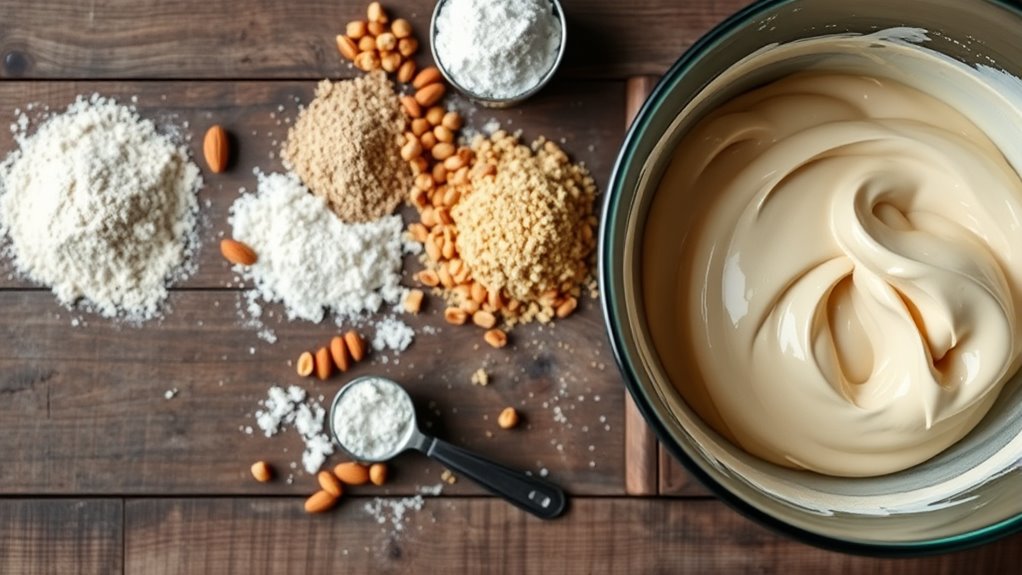
Understanding how gluten-free dough behaves helps you attain the right texture in your baked goods. You’ll notice differences in consistency, hydration, and how well ingredients bind together. Adjusting binding agents and hydration levels guarantees your dough holds together and bakes perfectly. Utilizing AI-powered analysis can further optimize ingredient ratios for ideal results. For instance, incorporating tuning techniques from car customization can inspire precise adjustments in ingredient amounts to achieve optimal dough performance. Reflecting on fatherhood wisdom can also remind bakers to approach with patience and care, ensuring each batch turns out with love. Regularly monitoring projector bulb maintenance and adjusting baking conditions accordingly can improve overall baking results and consistency. Additionally, understanding the texture and behavior of different gluten-free flours can help tailor recipes to specific baked goods.
Gluten-Free Dough Consistency
Gluten-free doughs behave differently from traditional wheat-based versions because they lack the structure-building gluten protein. This absence affects dough consistency, making it more delicate and prone to crumbling if not handled carefully. You’ll notice that during dough fermentation, it doesn’t rise as much, and gluten development is limited, which influences elasticity and stretchiness. To achieve the right consistency, you need to pay attention to texture and adjust ingredients accordingly.
- Feel the dough’s weight and moisture—trust your instincts.
- Celebrate small successes when the dough feels just right.
- Embrace the unique texture that makes gluten-free baking special.
Hydration and Texture
Hydration plays a crucial role in shaping the texture and behavior of gluten-free doughs. Proper hydration ensures your dough develops the right elasticity and crumb structure, which is essential since gluten content is absent. When you add enough liquid, the flour particles absorb it, creating a cohesive dough that’s easier to work with and results in a better final product. Additionally, well-hydrated doughs enhance the nutritional benefits of your baked goods, as moisture helps retain vitamins and minerals. Too little hydration makes the dough crumbly and difficult to shape, while too much can cause stickiness and loss of structure. Achieving the right balance improves not only texture but also maximizes the nutritional advantages of gluten-free ingredients. Advancements in baking tools and techniques are also influencing the development of better baking tools and techniques, leading to more consistent results, especially in gluten-free baking. Incorporating hydration techniques can further refine the dough’s texture and handling properties, making the baking process more predictable and successful.
Binding Agents Effect
Proper hydration sets the stage for achieving the right dough consistency, but binding agents are what hold it all together. They enhance dough elasticity, giving gluten-free baked goods the structure and chewiness you crave. Without these agents, your dough may be crumbly or too sticky, making shaping difficult and affecting final texture. When used correctly, binding agents create a cohesive dough that rises well and maintains its shape.
Feel the difference as your dough becomes more manageable, less fragile, and more like traditional bread or pastry. The right binding agents can turn a challenging batch into a satisfying bake. Trust in their power to bring your gluten-free creations to life with perfect texture and resilience.
- Experience the joy of perfect dough elasticity
- Feel confident in shaping your baked goods
- Achieve bakery-quality textures every time
Tips for Achieving Authentic Italian Flavors Without Gluten
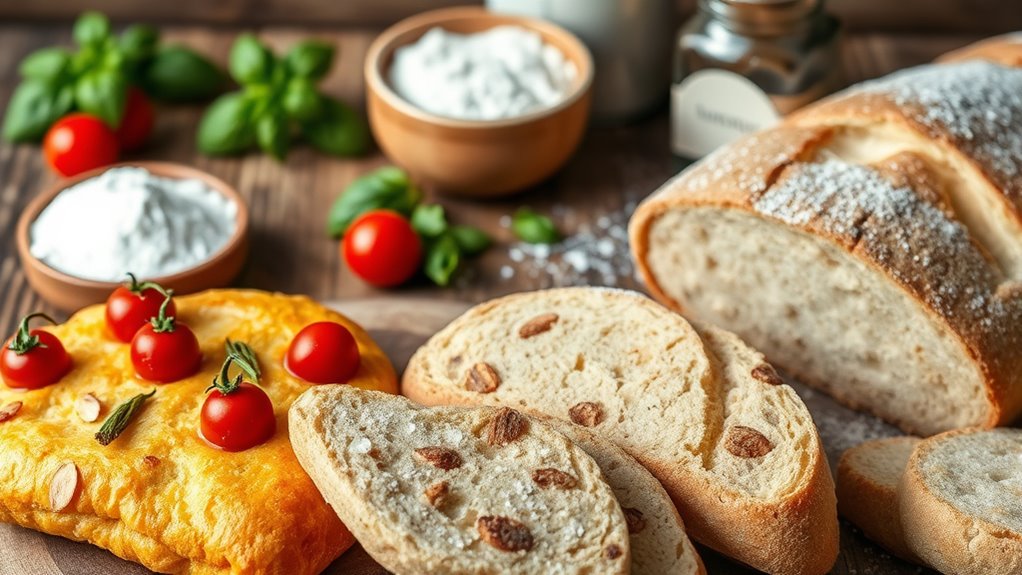
Achieving authentic Italian flavors without gluten is all about selecting the right ingredients and mastering traditional techniques. To prevent gluten cross contamination, keep your workspace and tools thoroughly clean, and use dedicated utensils for gluten-free baking. Focus on authentic Italian baking traditions, such as incorporating regional herbs, spices, and natural flavor enhancers like olive oil and aged cheeses. Use high-quality gluten-free flours that mimic the textures and flavors of traditional ingredients, and consider adding subtle flavor boosts like lemon zest or fresh herbs. Pay close attention to the balance of acidity and richness, which are hallmarks of Italian cuisine. Additionally, understanding the gluten-free baking process can help improve texture and flavor, ensuring your baked goods are both delicious and safe for those with sensitivities. Recognizing the importance of traditional Italian ingredients can elevate your baking to maintain an authentic taste. Incorporating advanced AI processing techniques can also assist in refining recipes and optimizing ingredient blends for better results. Being mindful of texture and moisture is essential to replicate the characteristic mouthfeel of traditional Italian baked goods. By respecting these traditions and maintaining strict hygiene, you can create gluten-free baked goods that capture the true essence of Italian flavors. Moreover, experimenting with innovative techniques can help you adapt classic recipes while preserving their authentic character.
Combining Flours for Better Structure and Taste
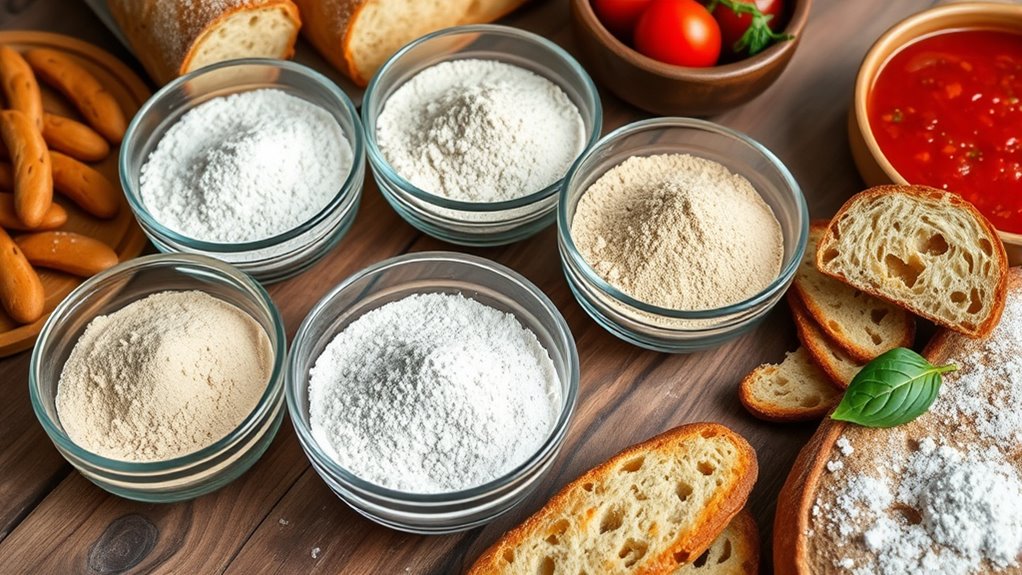
By mixing different gluten-free flours, you can enhance the texture and density of your baked goods. Combining flours also helps balance flavor profiles and enhances dough elasticity. This approach guarantees your baked items are both flavorful and have the right structure. Incorporating bike maintenance techniques, such as using smart kitchen gadgets, can also streamline your baking process and ensure precision. For example, precise temperature control tools can help maintain consistent baking conditions, similar to how Vetted electric bike conversion kits ensure reliable performance.
Enhancing Texture and Density
Combining different gluten-free flours can substantially improve the texture and density of baked goods, since no single flour perfectly mimics traditional wheat flour. By blending flours like rice, tapioca, and chickpea, you create a more structured, satisfying crumb. This approach reduces the risk of gluten cross contamination, guaranteeing your treats stay safely gluten-free and meet strict gluten free labeling standards. Incorporating antioxidants from various flours can also help preserve freshness and improve the nutritional profile of your baked goods. Consider these benefits: – Achieve a richer, more authentic Italian bread texture – Enhance flavor complexity with diverse flour profiles – Boost overall moisture and resilience in your baked goods
Experimenting with flour combinations allows you to tailor textures to your preferences while maintaining gluten-free integrity. This assures your baked goods are both delicious and safe for those with gluten sensitivities.
Balancing Flavor Profiles
Balancing flavor profiles when combining gluten-free flours is vital for creating baked goods that taste as good as they look. Traditional flavor plays a key role, so choose flours that complement each other and enhance the overall taste. For example, almond flour adds richness, while rice flour offers a neutral base, allowing other ingredients to shine. Ingredient pairing is essential — pairing a slightly sweet flour with a more savory one creates a harmonious flavor balance. Tasting as you go helps you adjust ratios for the best result. Keep in mind that some flours may have distinct flavors, so combining them thoughtfully ensures your baked goods maintain authentic Italian character without overpowering the dish. This balance elevates both flavor and aroma, making your gluten-free treats truly delightful.
Improving Dough Elasticity
To improve dough elasticity in gluten-free baking, selecting the right flour combinations is essential. Combining flours like rice, tapioca, and potato starch creates a better structure and enhances taste. These blends help mimic gluten’s stretchiness, making your dough more manageable. To achieve ideal results, use fermentation techniques like slow proofing, which develop flavor and improve elasticity. Be mindful of gluten cross contamination—use dedicated tools and ingredients to prevent unwanted gluten exposure. You can also add natural binders like xanthan gum or psyllium husk to strengthen the dough’s stretchiness. Embrace the process, and you’ll create beautifully elastic dough that rises perfectly and offers satisfying texture, elevating your gluten-free Italian baked goods.
Using Binders to Improve Dough Elasticity and Cohesion

When working with gluten-free dough, adding effective binders is essential to enhance its elasticity and cohesion. Binders like xanthan gum, guar gum, or psyllium husk help mimic gluten’s structure, making your dough more flexible and less crumbly. Incorporate these binders early in your mix to ensure even distribution. Natural fermentation can also improve dough strength, but it’s vital to control your baking temperature; too high can weaken the binders, while too low might slow fermentation. Adjust your oven settings based on the recipe, aiming for a steady heat that supports proper gluten-free dough development. Using the right binders, along with mindful temperature control, results in a dough that’s easier to shape and yields a better texture in finished baked goods.
Adapting Classic Italian Recipes to Gluten-Free Versions
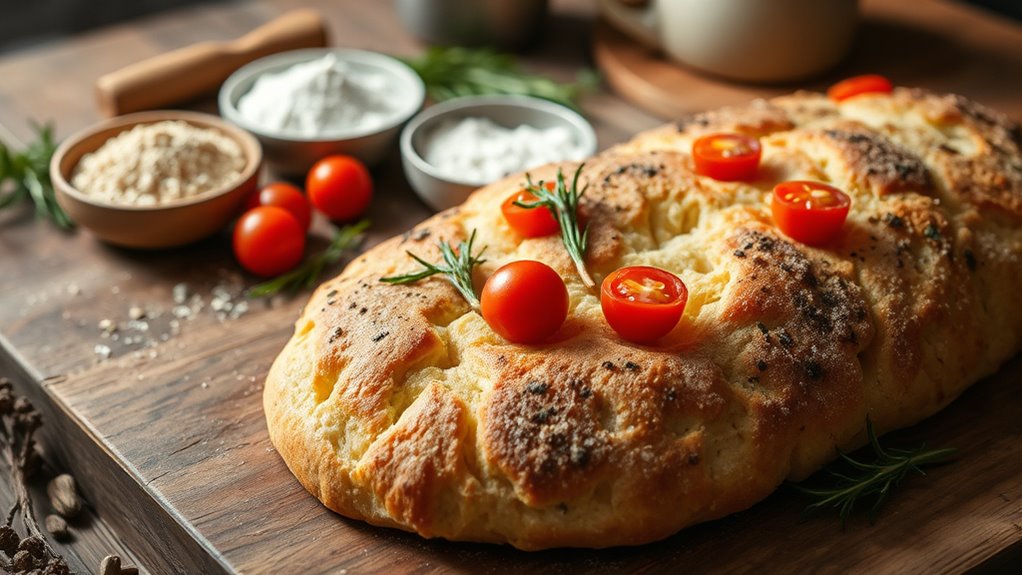
When adapting classic Italian recipes to be gluten-free, you need to choose the right alternative flours and tweak your techniques to get the best results. It’s important to preserve the authentic flavors that make these dishes special, even without traditional wheat. With some adjustments, you can create delicious gluten-free versions that stay true to their roots.
Substituting Traditional Flours
Replacing traditional flours in Italian baking requires understanding how different gluten-free options behave. Gluten-free fermentation can be slower and more sensitive, so selecting the right flour blend is key. Using traditional Italian ingredients like chestnut flour or rice flour adds authentic flavor and texture. Experimenting with these alternatives can transform your recipes into delicious, gluten-free versions of classics. When substituting, consider how each flour impacts moisture, elasticity, and rise, as some may require adjustments or additional binding agents. Embrace the challenge and let these options inspire creativity in your kitchen.
- Feel the joy of recreating beloved recipes with authentic, gluten-free ingredients
- Experience the satisfaction of mastering gluten-free fermentation techniques
- Discover new flavors that deepen your connection to Italian culinary traditions
Adjusting Dough Techniques
Adapting classic Italian doughs to gluten-free versions requires careful technique adjustments to achieve the right texture and structure. Since gluten provides elasticity and strength, you need to pay extra attention to dough fermentation, ensuring it develops flavor and proper rise. Longer fermentation times often help improve elasticity and flavor, so be patient. When working with gluten-free doughs, you may also need to modify oven temperatures; a slightly higher temperature can help create a better crust and ensure thorough baking. Use a preheated, properly calibrated oven, and consider baking on a pizza stone or steel for even heat distribution. These adjustments help compensate for the lack of gluten, resulting in a more authentic, satisfying Italian baked good.
Preserving Authentic Flavors
Maintaining the authentic flavors of traditional Italian baked goods while working with gluten-free ingredients involves more than just substituting flours; it requires careful attention to ingredients that capture the essence of classic recipes. To truly honor Italian baking traditions, focus on enhancing flavors with natural ingredients like fresh herbs, high-quality olive oil, and traditional spices. Incorporate carefully selected gluten free beverages, such as robust wines or aromatic liqueurs, to deepen complexity. Remember, balancing textures and flavors is key. You can evoke emotion and authenticity by:
- Using traditional seasonings and fresh, local ingredients
- Pairing baked goods with authentic gluten free beverages
- Preserving the aroma and taste that define Italian baking traditions
This approach ensures your gluten-free creations remain true to their roots.
Common Mistakes to Avoid in Gluten-Free Italian Baking
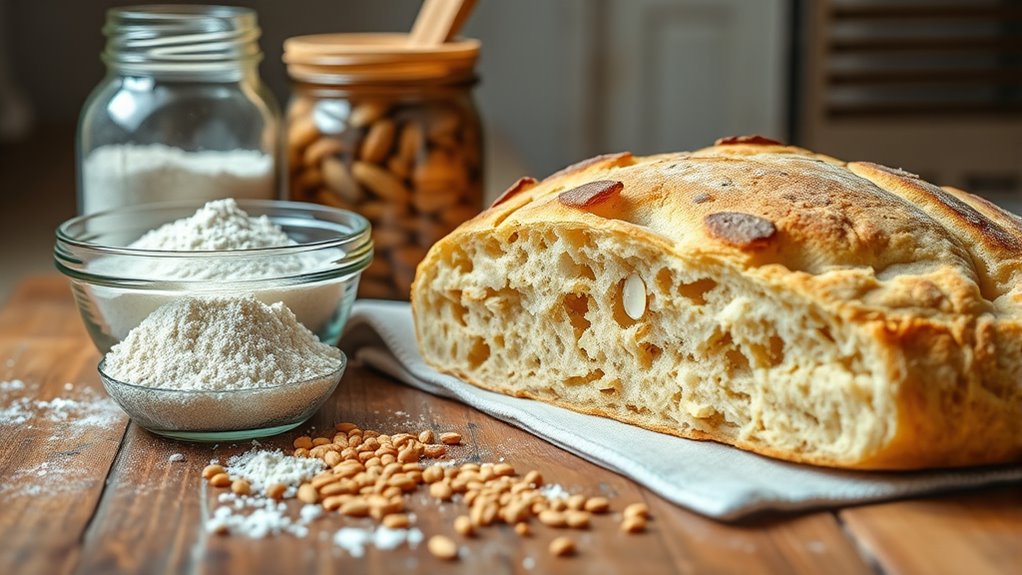
One of the most common mistakes in gluten-free Italian baking is not understanding how different flours behave, which can lead to dense or crumbly results. It’s crucial to choose flours that match the recipe’s needs and to measure them accurately. Avoid gluten cross contamination by using dedicated utensils, storage containers, and workspaces to keep your ingredients truly gluten-free. Don’t rely solely on gluten free labeling; always check ingredient lists to ensure there’s no hidden gluten or contamination risks. Rushing through ingredient prep or substituting flours without understanding their properties can also compromise your baked goods. Taking these precautions helps you avoid common pitfalls and ensures your baked Italian treats are authentic, flavorful, and safe for gluten-sensitive diets.
Recommended Gluten-Free Flours for Specific Italian Pastries
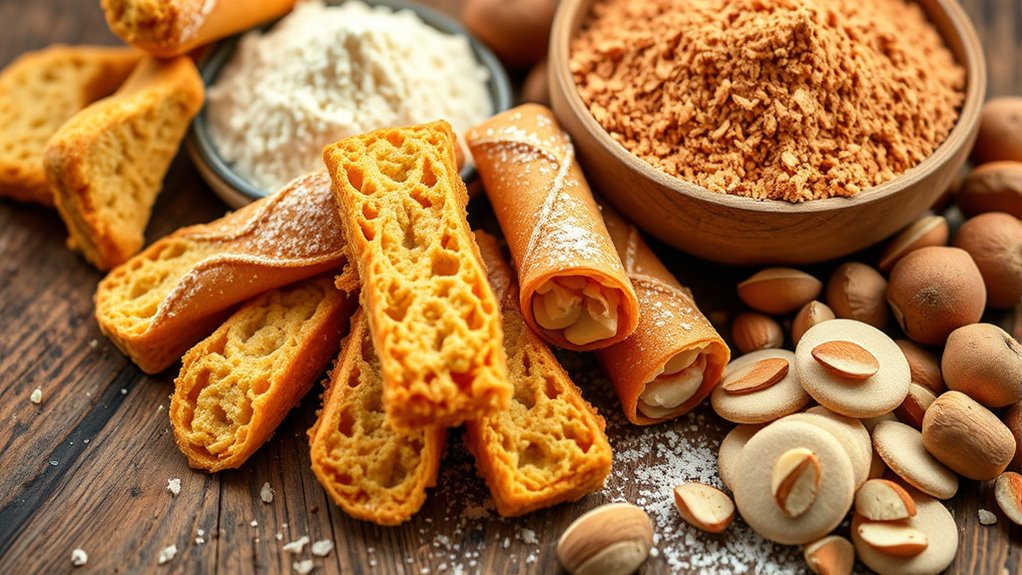
Choosing the right gluten-free flours makes all the difference when baking authentic Italian pastries. Different flours bring unique textures and flavors that honor italian baking history while offering gluten free nutritional benefits. For delicate cannoli shells, use rice flour combined with tapioca starch for a crisp, light texture. Almond flour adds richness and depth to amaretti cookies, connecting tradition with modern gluten-free options. For dense, flavorful panettone, chestnut flour offers a nutty profile aligned with regional ingredients. These flours not only improve taste but also boost nutritional value, making your baked goods more wholesome. Embrace these alternatives to transform classic recipes into gluten-free delights that celebrate Italy’s baking heritage and support your health.
Techniques for Handling and Shaping Gluten-Free Doughs
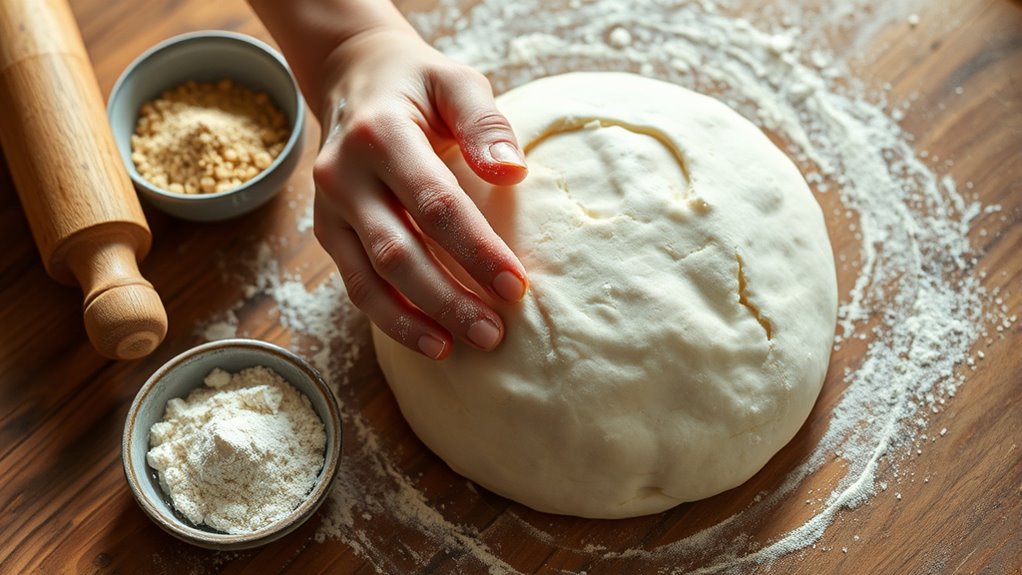
Handling and shaping gluten-free doughs requires a gentle touch because they lack the elastic gluten network that traditional doughs rely on. To prevent sticking, lightly flour your work surface and hands, or use parchment paper. Since gluten-free doughs don’t develop the same structure, dough fermentation is essential; allow it to rest and hydrate fully to improve elasticity. When shaping, avoid overworking the dough, which can lead to density. Use a light touch and gentle pressure. Pay close attention to oven temperature, as gluten-free baked goods often need a slightly higher heat to guarantee proper rise and texture. Preheat your oven thoroughly, and consider using a baking stone or steel for even heat distribution. These techniques help achieve better handling, shaping, and baking results.
Storage and Shelf Life of Gluten-Free Italian Baked Goods

Storing gluten-free Italian baked goods properly is essential to maintain their freshness and texture. Using the right packaging methods helps prevent staleness and preserves flavor. Wrap items tightly in plastic wrap or store them in airtight containers to keep moisture in and air out. For longer shelf life extension, consider freezing baked goods, which maintains quality for weeks. When thawing, do so at room temperature to avoid sogginess. Keep baked goods away from direct sunlight and heat to prevent spoilage. Proper storage not only prolongs freshness but also preserves the delightful taste and texture you worked hard to achieve.
Properly store gluten-free Italian baked goods in airtight containers or wrap tightly to keep them fresh and flavorful.
- Feel confident knowing your baked creations stay moist and delicious.
- Experience the joy of sharing fresh, authentic Italian treats anytime.
- Avoid waste and enjoy your gluten-free favorites longer.
Frequently Asked Questions
How Do Gluten-Free Flours Affect the Rising Time of Italian Bread?
Gluten-free flours slow down gluten-free fermentation and affect bread rising dynamics. You might notice longer rising times because these flours lack the gluten network that traps gases and helps dough rise. To improve rising, you can add natural binders or use specific gluten-free flour blends designed for better fermentation. Adjust your proofing times accordingly, and be patient—your Italian bread will develop its texture despite the different rising process.
Can I Substitute Gluten-Free Flours in Traditional Italian Pasta Recipes?
You can substitute gluten-free flours in traditional Italian pasta recipes, but be aware it may change the textures of your pasta. Gluten-free pasta tends to be more delicate and may lack the elasticity seen in traditional dough. To improve gluten-free pasta textures, try blending different flours or adding binding agents. While it’s possible to adapt recipes for gluten-free cooking, expect some differences from authentic Italian cooking results.
What Are the Best Gluten-Free Options for Making Italian Biscotti?
Imagine biting into a crisp, golden biscotti—now, you can make that happen gluten-free. For the best results, try almond flour for a tender, nutty flavor, and chickpea flour for a hearty, slightly savory twist. Both options work well in Italian biscotti recipes, providing structure and taste. You’ll love how these alternatives let you enjoy authentic flavors without gluten, making your baking both delicious and inclusive.
How Do I Prevent Gluten-Free Baked Goods From Becoming Too Dense?
To prevent your gluten-free baked goods from becoming too dense, focus on texture improvement through proper leavening techniques. Use a combination of baking soda and vinegar or whipped egg whites to add lift. Incorporate xanthan gum or guar gum to improve elasticity. Additionally, avoid overmixing the batter, which can compact the dough. These methods help create a lighter, airier texture, making your baked goods more enjoyable.
Are There Specific Gluten-Free Flours That Mimic Italian Semolina Flavor?
Imagine trying to recreate Italian semolina’s warm, nutty charm with a gluten-free twist—quite the culinary adventure! While no gluten-free flour perfectly mimics the rich flavor of traditional semolina, gluten-free semolina or Italian flour substitutions like millet or sorghum can bring you closer. These options offer a similar texture and taste, making your baked goods feel authentic without sacrificing gluten-free integrity. Just be ready for some delicious experimentation!
Conclusion
By experimenting with different flours and techniques, you can create delicious, authentic Italian baked goods gluten-free. For example, imagine perfecting a flaky sfogliatella by blending rice and tapioca flours, achieving the right texture without gluten. With patience and practice, you’ll master the art of gluten-free Italian baking, impressing family and friends alike. Keep learning, adjusting, and savoring each success—your gluten-free Italian treats will become just as authentic and delightful as traditional ones.
